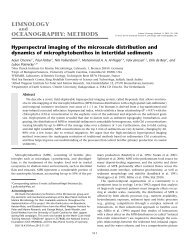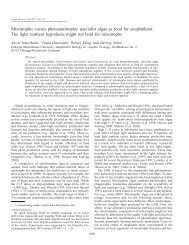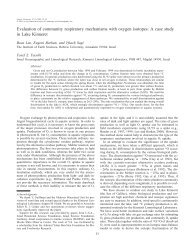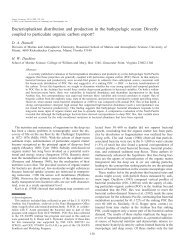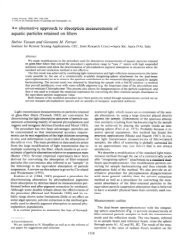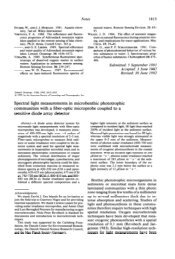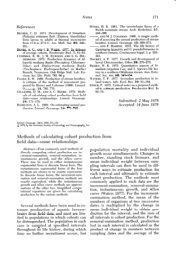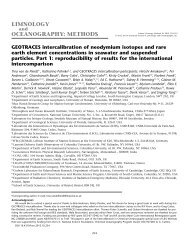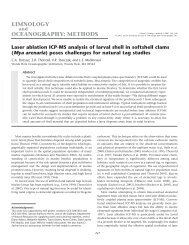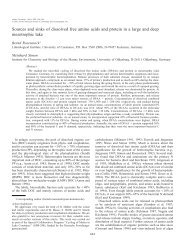Chia Yu Lin and Steven L. Manley. Bromoform production from - ASLO
Chia Yu Lin and Steven L. Manley. Bromoform production from - ASLO
Chia Yu Lin and Steven L. Manley. Bromoform production from - ASLO
Create successful ePaper yourself
Turn your PDF publications into a flip-book with our unique Google optimized e-Paper software.
Workshop 9: Passive Nonlinear Targeted Energy<br />
Transfer in Coupled Oscillators<br />
Sunday, August 28, 2011<br />
8:00am–12:00pm Location: Concord<br />
Instructors: Alex<strong>and</strong>er F. Vakakis<br />
(avakakis@illinois.edu)<br />
Lawrence A. Bergman<br />
(lbergmany@illinois.edu)<br />
D. Michael McFarl<strong>and</strong><br />
(dmmcf@illinois.edu)<br />
Overview:<br />
In this tutorial, the presenters will discuss the fundamentals <strong>and</strong><br />
some applications of a new, fully passive, paradigm for<br />
protecting critical systems <strong>from</strong> destructive force <strong>and</strong> motion<br />
inputs: targeted energy transfer (TET). The novelty of this<br />
approach is its applicability to wide-b<strong>and</strong> <strong>and</strong> transient inputs,<br />
as well as the usual narrow-b<strong>and</strong> <strong>and</strong> steady-state excitations.<br />
The method represents a new <strong>and</strong> unique application of strong<br />
intentional nonlinearity, the nonlinear energy sink (NES), a local,<br />
simple, lightweight subsystem capable of completely altering<br />
the global behavior of the primary system to which it is attached.<br />
The underlying mechanism, a series of transient resonance<br />
captures <strong>and</strong> escapes, combined with nonlinear beating<br />
phenomena associated with excitation of special impulsive<br />
orbits which comprise the bridges to TET, provides an entirely<br />
different passive approach to quickly, efficiently, <strong>and</strong> nearly<br />
irreversibly moving vibration energy in a preferred, a priori<br />
selected direction <strong>from</strong> the primary system to an NES where it<br />
can be localized <strong>and</strong> harmlessly dissipated. Some first<br />
applications of TET through the use of both smooth <strong>and</strong><br />
discontinuous NESs will be demonstrated in the areas of<br />
aeroelastic flutter suppression, vibration <strong>and</strong> shock isolation,<br />
blast protection <strong>and</strong> seismic mitigation. Additional potential<br />
applications of the technology currently under investigation,<br />
such as vibration control of bluff bodies in flow, broadb<strong>and</strong><br />
acoustic attenuation, <strong>and</strong> broadb<strong>and</strong> vibration amplification for<br />
energy harvesting will be discussed.<br />
52<br />
Workshop 10: Creative Design of Parallel<br />
Mechanisms<br />
Sunday, August 28, 2011<br />
1:00pm–5:00pm Location: Congressional B<br />
Instructors: Xianwen Kong (x.kong@hq.ac.uk)<br />
Clement Gosselin<br />
(gosselin@gmac.ulaval.ca)<br />
WORKSHOPS<br />
Overview:<br />
During the past decade, significant progress has been made in<br />
the type synthesis (creative design or conceptual design) of<br />
parallel mechanisms. These advances have led to a concise<br />
approach – the virtual-chain approach – to the type synthesis of<br />
parallel mechanisms. In this approach, parallel mechanisms can<br />
be constructed using several compositional units. Unfortunately,<br />
it is not well realized that the virtual-chain approach can be<br />
applied by engineers <strong>and</strong> researchers with basic knowledge in<br />
mathematics <strong>and</strong> mechanisms (mechanics) taught in<br />
undergraduate courses. In order to fill the gap between research<br />
<strong>and</strong> practice, this tutorial aims at presenting the fundamental<br />
principles of the virtual-chain approach to the type synthesis of<br />
parallel mechanisms <strong>and</strong> at illustrating step by step how parallel<br />
mechanisms are constructed using this approach. As a byproduct,<br />
one can carry out the mobility analysis of parallel<br />
mechanisms following the reverse process of the type synthesis.<br />
Then the type synthesis of translational parallel manipulators<br />
with linear input-output equations will be discussed. Some open<br />
issues in the type synthesis of parallel mechanisms, especially<br />
parallel mechanisms with multiple operation modes <strong>and</strong><br />
compliant translational parallel manipulators, will also be<br />
presented.




